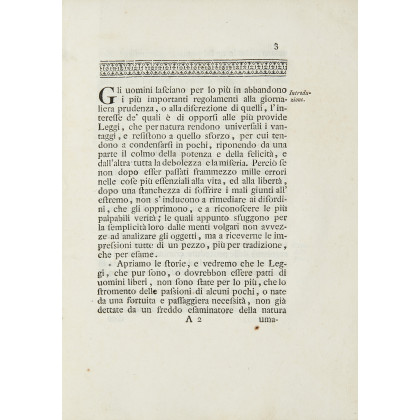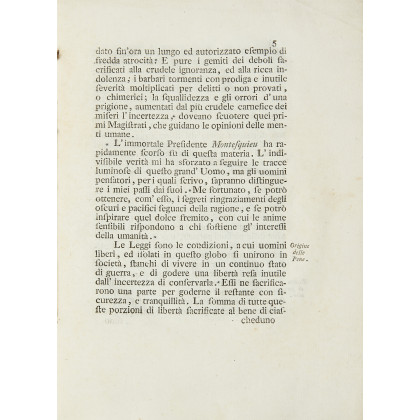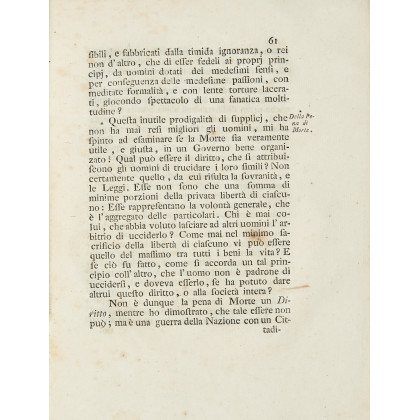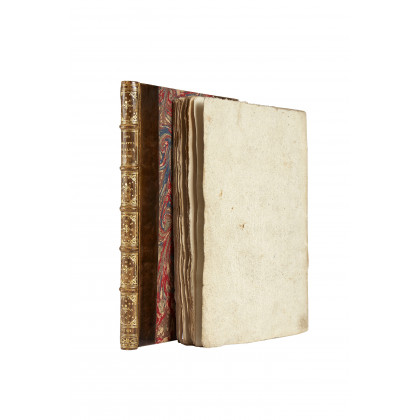
Lot n° 13 | Auction 625
Estimate € 12,000 - 18,000
Auction: 19 September 2023 at 10:00
BECCARIA, Cesare (1738-1794) - Dei Delitti e delle pene. [Livorno: Tipografia Coltellini], 1764. An excellent copy in contemporary boards, uncut and therefore with wide margins: the measurements are 4 or 5mm larger than the copies on the market or those sold at auction in recent years. First edition of "one of the most influential works in the entire history of criminology" (PMM). The work has "significantly shaped the views of American revolutionaries and lawmakers" (Bessler). Beccaria maintained that the gravity of the crime should be measured by its injury to society and that the penalties should be related to this. The prevention of the crime he held to be of greater importance than its punishment, and the certainty of punishment of greater effect than its severity. [His] ideas have now become so commonplace that it is difficult to appreciate their revolutionary impact at the time (PMM). Beccarias' criticism of the death penalty and torture is another essential part of the work: "Qual può essere il diritto, che si attribuiscono gli uomini di trucidare i loro simili? Non certamente quello, da cui risulta la sovranità, e le Leggi. Non è dunque la pena di Morte un Diritto, mentre ho dimostrato, che tale essere non può; ma è una guerra della Nazione con un Cittadino, perchè giudica necessaria, o utile la distruzione del suo essere: Ma se dimostrerò non essere la Morte nè utile, nè necessaria, avrò vinto la causa dell'umanità". As soon as it was published, the work was included in the index of prohibited books by the Holy Office; it is no coincidence that Marco Coltellini's typography in Livorno was chosen as the place of printing, a city at the time the site of an English colony and a context more open to change, in favour of the Enlightenment and opposed to restrictions and censorship. The book was reprinted in six editions during the following 18 months and translated into most European languages. Bessler, "The Italian Enlightenment and the American Revolution", Journal of Public Law and Policy, vol. 37; Einaudi 380; PMM 209. 8vo (223 x 162mm). Woodcut device on title (minimal light browning some occasional spotting). Without errata at end which is found only in some copies and was probably added later. The "Bibl. dell'Ediz. Naz" (n.1) expresses itself as follows regarding the errata: "only in some rare copies there is an added supplementary leaf (errata)" defining it "a late addition to the original edition". Editorial boards with elegant stitching visible on the spine, uncut (minimal stains, an erased note on front cover); preserved in an elegant half-leather chemise with gilt titled spine and matching slipcase (minor rubbing). Provenance: Nádasd-Ladányi Könyvtár (label on the cover and Hungarian private library stamp on title) - Mario Serandrei (1907-1966; exlibris of the renown screenwriter) - "Editio princeps insignis raritatis" (ownership inscription at counterplate dated 1956).
Estimate € 12,000 - 18,000












